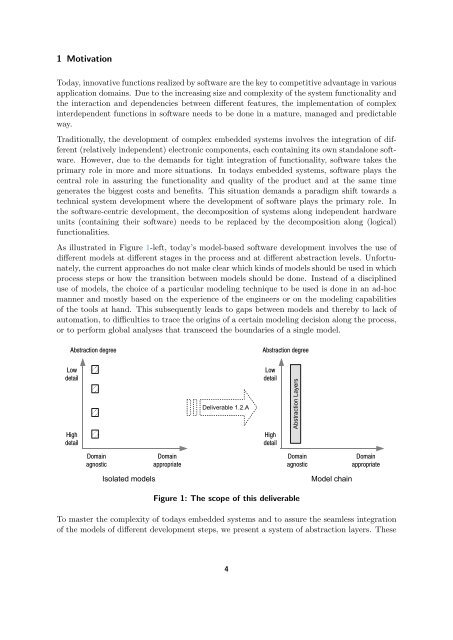SPES 2020 Deliverable D1.2.A-1 Abstraction Layers
SPES 2020 Deliverable D1.2.A-1 Abstraction Layers
SPES 2020 Deliverable D1.2.A-1 Abstraction Layers
Create successful ePaper yourself
Turn your PDF publications into a flip-book with our unique Google optimized e-Paper software.
1 Motivation<br />
Today, innovative functions realized by software are the key to competitive advantage in various<br />
application domains. Due to the increasing size and complexity of the system functionality and<br />
the interaction and dependencies between different features, the implementation of complex<br />
interdependent functions in software needs to be done in a mature, managed and predictable<br />
way.<br />
Traditionally, the development of complex embedded systems involves the integration of different<br />
(relatively independent) electronic components, each containing its own standalone software.<br />
However, due to the demands for tight integration of functionality, software takes the<br />
primary role in more and more situations. In todays embedded systems, software plays the<br />
central role in assuring the functionality and quality of the product and at the same time<br />
generates the biggest costs and benefits. This situation demands a paradigm shift towards a<br />
technical system development where the development of software plays the primary role. In<br />
the software-centric development, the decomposition of systems along independent hardware<br />
units (containing their software) needs to be replaced by the decomposition along (logical)<br />
functionalities.<br />
As illustrated in Figure 1-left, today’s model-based software development involves the use of<br />
different models at different stages in the process and at different abstraction levels. Unfortunately,<br />
the current approaches do not make clear which kinds of models should be used in which<br />
process steps or how the transition between models should be done. Instead of a disciplined<br />
use of models, the choice of a particular modeling technique to be used is done in an ad-hoc<br />
manner and mostly based on the experience of the engineers or on the modeling capabilities<br />
of the tools at hand. This subsequently leads to gaps between models and thereby to lack of<br />
automation, to difficulties to trace the origins of a certain modeling decision along the process,<br />
or to perform global analyses that transceed the boundaries of a single model.<br />
<strong>Abstraction</strong> degree<br />
Low<br />
detail<br />
High<br />
detail<br />
Domain<br />
agnostic<br />
Isolated models<br />
Domain<br />
appropriate<br />
<strong>Deliverable</strong> 1.2.A<br />
<strong>Abstraction</strong> degree<br />
Low<br />
detail<br />
High<br />
detail<br />
<strong>Abstraction</strong> <strong>Layers</strong><br />
Domain<br />
agnostic<br />
Figure 1: The scope of this deliverable<br />
Model chain<br />
Domain<br />
appropriate<br />
To master the complexity of todays embedded systems and to assure the seamless integration<br />
of the models of different development steps, we present a system of abstraction layers. These<br />
4
















